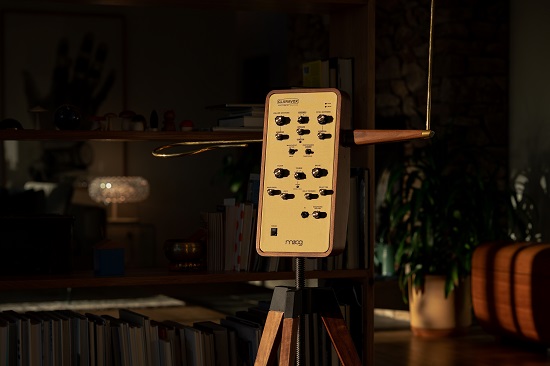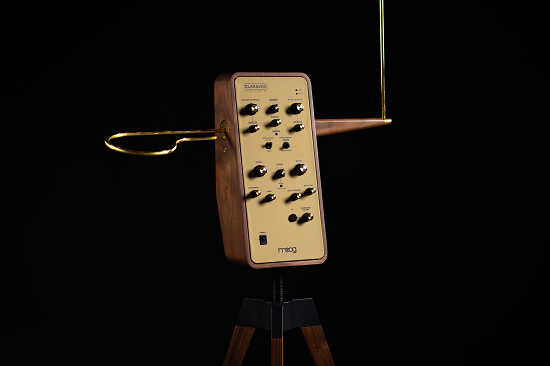Today, Moog has announced The Claravox Centennial Theremin, a new edition of the instrument that revolutionised music.
Named in honour of Clara Rockmore, a violin prodigy and one of the theremin’s most virtuosic players, the new edition also marks exactly one hundred years since Lev Theremin invented the instrument.
In the 1950s, though the theremin’s popularity was fading, one member of a niche community of kit-builders was Robert Moog, whose interest in the instrument led in part to his invention of the similarly revolutionary Moog synthesiser.
The company would go on to manufacture theremins of their own, and with the Claravox aim to encompass the instrument’s past, present and future. It has two switchable performance modes – ‘Traditional’ and ‘Modern’ – allowing players to select between classic heterodyne analog oscillators and multimode DSP oscillators with assignable scales, quantisation and octave ranges.
To find out more about the new design, tQ caught up with Moog CTO, and the new instrument’s designer, Cyril Lance. Also below, you can find a fantastic vintage audio piece featuring a mix of Clara Rockmore’s songs paired with vocal clips from Rockmore , Bob Moog, and Lev Theremin.
tQ: Tell me about your personal relationship with the theremin. When did you first hear it, and what did you make of the sound? Can you remember the first time you got to play one?
CL: Before meeting Bob Moog in 2005 I had only a vague cultural association with the theremin like most people and I knew nothing about the incredible history and legacy of the instrument. My very first day at Moog, the Etherwave [theremin] production line was down. I walked back into engineering and [senior Moog engineer] Steve Dunnington was there with an Etherwave open and demonstrating the production issue. Solving the issue with Steve was my introduction to the theremin. I took one home with me that night and also started reading Albert Glinsky’s incredible biography of Lev Theremin’s life Ether Music and Espionage which was an entrancing introduction to the history of the instrument and its journey through the 20th century.
At that point, I started studying Bob’s theremin schematics and also Lev Theremin’s schematics and learning as much as I could about the physics and principles of the instrument. Shortly after that, I met Pamelia Stickney, one of the world’s foremost theremin virtuosos and was amazed at her facility on the instrument and her range of creative expression. We became great friends and she was essential in teaching me about the subtleties of the instrument.

The theremin is such a mystical experience to play as you really become part of the instrument. I was immediately drawn to playing it and could sense just how expressive an instrument it was, but also just how hard it was to master. As I grew relationships with more and more theremin players from around the world, it never ceased to amaze me just how diverse and wide ranging the styles and expression of the instrument is.
Did you ever have any conversations with Bob Moog about theremins?
CL: Unfortunately, I had very little time directly with Bob as he became sick so quickly after I began at Moog. Most of our discussions were on a much deeper level at that point. I really wish that I had had the opportunity to learn more from him in person, though, as he possessed an extraordinary depth of knowledge about the instrument. I have listened to interviews and learned from having conversations with his circuits only. Steve Dunnington worked very closely with Bob on many of his theremin designs, though, and carries much of the knowledge and passion that Bob had for the instrument.
When was the decision made to create a 100th anniversary edition of the instrument?
CL: We decided that we would create a 100th anniversary edition theremin in the spring of 2019 and started talking about many different ideas about what such an instrument could be. The theremin is such a large part of our company legacy and an important milestone in the history of electronic music. The decision to honour the anniversary with a new theremin design was one we were excited to make.
What was your approach with the design?
CL: I think the decision pivoted around whether we wanted to make a purist theremin fully honouring and duplicating the essence of Lev’s instrument through Bob’s evolution of the instrument or whether we wanted to create a new and forward -looking instrument to honour the innovative spirit of both Lev and Bob’s contributions to the history of electronic music. Both Lev and Bob were pivotal during their time. Both were physicists and musicians learning their craft during pivotal evolutions of the sciences, culture and politics and used this new knowledge to create new classes of instruments for artist to express themselves with.
Ultimately, we decided that to honour both the essence of the theremin and the spirit embodied in both Lev and Bob’s contribution to the history of instrument design and music, we would try and create an instrument that could simultaneously be played in its simplest form as a traditional theremin but also augment this experience with a set of new capabilities that allowed artists to expand their sonic vocabularies on the instrument, have more control over the response curves of the instrument to accommodate different playing styles, and to offer the type of interconnectivity that both honours Bob’s modular legacy and also modern digital performance setups.
This didn’t come out of a vacuum, but only after hours and hours of conversations with a host of modern theremin players around the world that generously donated their time and visions to help define what this instrument would ultimately become. It was particularly inspiring to hear the excitement from the Theremin community about their desires to see the instrument evolve further and offer them more ability to push their expressive capability.
Tell me more about Clara Rockmore, and why you decided to name the new theremin in her honour?
CL: The first real theremin recordings I heard were that of Clara Rockmore. From the very first notes, I was transfixed. Her playing of Lev’s theremin transcends the instrument itself and immediately becomes a true voice – and you can instantly feel the deep connection between Clara and her instrument and her ability to play so emotionally. Her playing sounds organic and dynamic and one no longer wonders about the instrument but rather gets taken away by the music. To me, this is the highest achievement and embodies the relationship between the artist and the instrument and how they become something larger than the two.
Lev and Clara’s relationship also embodies how the instrument maker needs that partnership with the artist and this was a process that Bob embodied as well. It is built into our DNA here at Moog in how we approach what we do and is one of the aspects of our work that I cherish.
The development of Claravox would not have been possible without the partnerships with our artists, most notably, Dorit Chrysler, Pamelia Stickney and Gregoire Blanc. Some of these discussions and visions are the result of 15 years of conversations, many visits, working directly with instruments and learning from their experience and expertise. The generosity and deep friendships that develop during these creative processes are invaluable and I feel form the foundation of our work. I have such deep appreciation and respect for all the artists that have contributed to the vision of the instrument.
When I brought the first prototype to Dorit Chrysler’s studio in New York City in February of 2020, we started playing it. Dorit had just come back from Paris where she had played a collection of vintage theremins, both some of Lev’s early instruments and Bob’s. She was struck by the deep, organic tone of some of these instruments. When she played the prototype, she was moved by its tone and inspired by the experience she just had in Paris. Dorit talked about how she felt the new instrument had a soul that would inspire Clara Rockmore. This stuck with us and over the days we were working together, she came up with the idea of honoring Clara through the name of the instrument.
Like Pamelia, Dorit has collaborated and shared her visions with us for over ten years – the name Claravox seems to capture, then, so much about the Theremin: it’s history and legacy, the collaboration between artist and instrument designer, the musical depth of expression and virtuosity, and the willingness to look forward to help create something new while honoring the past.


